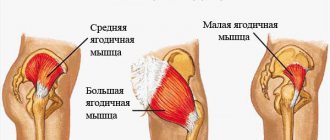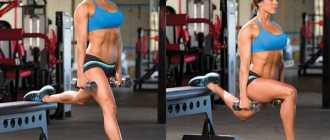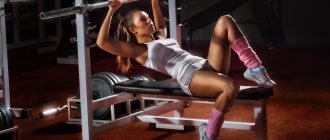Author: Timko Ilya - the ruler of the entire site and fitness trainer | more details >> Rod. 1984 Trained since 1999 Trained since 2007. Author and creator of the site tvoytrener.com. CCM in powerlifting. Champion of Russia and South Russia according to AWPC. Champion of the Krasnodar region according to IPF. 1st category in weightlifting. 2-time winner of the Krasnodar Territory championship in t/a. Author of more than 700 articles on fitness and amateur athletics. Author and co-author of 5 books.
Place in the author rating:
out of competition
(become an author) Date: 2012-05-29 Views: 457,022 Rating: 5.0
| All articles by the author >> | Medals articles >> |
Articles are loading...
| Article medals: | more than 100 thousand views |
Why medals are given to articles:
| Bronze medal: | |
| 1. The article is in the TOP 100 2. The article has more than 3. The article has more than 100 | |
| Silver medal: | |
| 1. The article is in the TOP 50 2. The article has more than 3. The article has more than 500 | |
| Gold medal: | |
| 1. The article is in the TOP 10 2. The article has more than 1 3. The article has more than 1,000 | |
Primary muscles - gluteus maximus and quadriceps femoris Additional - posterior thigh Difficulty - medium
Lunges forward with a barbell, exercise technique
Carefully, maintaining balance and balance, take a step forward with your right foot and squat on it. The step width is about a meter (depending on your height). Keep your torso upright throughout the entire movement. At the bottom of the movement, the thigh of the forward leg should be parallel to the floor. The back, supporting leg, also bends at the knee.
Push off the floor with your forward leg and return to the starting position (standing straight with the barbell on your shoulders).
Then step forward with the other foot (in our case, the left). Lower yourself into a lunge again and vigorously push back to the starting position. Continue alternating legs until you reach the desired number of repetitions. Then return the bar to the racks and take a good rest. Be sure to give yourself a chance to catch your breath before your next set, as lunges with a barbell greatly raise your heart rate and seriously increase your breathing rate.
Lunges forward with a barbell on your shoulders. Start.
Forward lunges with a barbell on your shoulders
Forward lunges with a barbell on your shoulders
Forward lunges with a barbell on your shoulders
What muscles work
Beginners who have started doing this exercise or are just about to get acquainted with it are wondering, “I do lunges with a barbell. What muscles work during this? This question can be answered simply - arms, legs, abs and buttocks. In fact, lunges with additional weight do not use all the muscles of these parts of the body; depending on the version of the exercise, the load on the body changes.
| Exercise | What muscles are involved? |
| Lunges in place |
|
| With stand | |
| With a barbell on your chest | |
| Reverse | |
| Dynamic | |
| Lateral |
|
| In Smith |
|
We did not include the arm and core muscles in the Smith exercise, because the barbell is fixed and the load on them is much less. The main load here goes to the legs and buttocks. In addition, most of these variations can be done using lunges with dumbbells.
Lunges with a barbell for girls will be very useful. Since the muscles of the abs, lower back, buttocks and thighs actively work during the exercise, blood circulation in the pelvic area increases. And this area is very important for women. By using side lunges, they will be able to tighten the inner thighs, which are difficult to work with other exercises. By performing lunges in motion, walking, girls will be able to quickly burn fat in problem areas of the lower body.
Separately, we would like to draw your attention to the weight, number of repetitions and approaches on each leg for beginners, depending on the gender of the athlete and his goals:
| Floor | Normal load | Load in smith | Number of repetitions | Approaches |
| Man | 15-20 kg | 20-30 kg | up to 15 | 3-4 |
| Woman pumping muscles | 8-12 kg | 10-15 kg | up to 15 | 3-4 |
| Woman, for weight loss | up to 10 kg | Not applicable | 20 at least | 3-4 |
Lunges with a barbell on the shoulders for men are almost the main exercise in the gym. While women are trying to lose weight with the help of exercise machines and pump up their buttocks, men are more focused on their limbs, working hard on their arms and legs, especially their thighs. Various lunges are a mandatory part of the training of bodybuilders and various heavyweight athletes.
Lunge options
You can perform forward lunges by doing all the repetitions on one leg first and then on the other. It's not very comfortable, but quite effective.
Another version of this exercise looks like this. Take a step forward, then simply squat down and stand on your forward leg. Having completed the required number of repetitions, put your second leg forward and do the required number of squats on it. Then rest.
And another option for lunges is to walk around the gym with a barbell on your shoulders, taking alternating steps with your left and right legs. This option will require a lot of free space.
Back lunges with a barbell on your shoulders Back lunges with dumbbells in your hands Forward lunges with dumbbells in your hands The 10 best exercises for your legs and glutes How to do a barbell snatch
- 3
Tags: lunges, knee-dominant exercises, pelvic-dominant exercises
Execution technique
Athletes who first encountered this exercise are often puzzled by “how to properly do lunges with a barbell so that they are beneficial and do not hurt themselves?” There is nothing complicated or supernatural about this. First of all, the person is required to:
- be able to do lunges;
- maintain balance in the exercise;
- do not confuse the working leg, which stands with the entire foot in front, with the supporting leg, which is behind and stands on the toe or on the side of the foot;
- keep your head straight and look straight ahead;
- work with additional weight and do not bend from it.
If these requirements are feasible for you, you can do lunges with a barbell, the technique and requirements for which are quite simple.
The most important thing when performing the exercise is that while you are in a vertical position, when you rise, you inhale, when you lower, you exhale.
Basic lunges
The technique of performing lunges with a barbell, using the example of the basic lunge exercise with a barbell on the shoulders, is as follows.
- You need to hang the weight that is optimal for you on the barbell.
- With both hands, lift the barbell and place it on your back at the top of your shoulder blades.
- Stand in a stance - hands hold the barbell, feet slightly wider than shoulder width, back straight.
- With your working leg we take a step forward and lower ourselves down. The knee of the working leg does not extend beyond the foot and forms a right angle between the thigh and lower leg. The supporting leg stands on the toes, the knee “hangs” above the floor.
- Stay in this position for a few seconds.
- Tightening the muscles of the working leg, strengthening the emphasis on the heel, push off the floor and return to a vertical position. This is how the return to the starting position occurs.
- You can “step”, changing legs each time, or perform several repetitions for each leg, changing them.
People who consider standing lunges with a barbell a boring and monotonous exercise are mistaken. There are several training variations with this equipment:
- with additional stand
- dynamic
- reverse
- side lunges
- with a barbell on the chest
- lunges with a barbell on a Smith machine
With additional stand
If, when performing the exercise, the working leg is placed on a small elevation (step platform, bench), the gluteal muscles will be more actively involved. If the supporting leg is located on the stand, the muscles of the legs and working leg will be better worked out. Depending on which area you want to work, choose the step width. To pump up the buttocks, the step should be large, for the legs – small, the distance between the legs is no more than 15 cm.
Dynamic lunges
Dynamic or walking exercises are most often used by athletes to lose weight. How to do these lunges with a barbell? You perform the first part of the basic movement - take a step and lower yourself. By pushing your working leg you rise to a vertical position. At this time, take a step with your supporting leg and lower yourself onto it. You can train on the spot, taking steps forward with one foot, the other back, or walking around the gym in this way.
Reverse lunges
The reverse lunge with a barbell is considered a more difficult variation of this exercise. The difficulty lies in stepping back, lowering down with the apparatus on your shoulders and maintaining balance. Many people have a psychological fear of the unknown. Taking a step without seeing where is difficult for them. Lunges with a barbell back help such people fight their phobias.
Side lunges
The name “side lunges” speaks for itself. In this exercise, the step is taken towards the working leg: right to right, left to left. The supporting leg in this exercise should be on the inside of the foot, the sneaker. Be sure to watch your knees and keep your back straight.
With a barbell on your chest
The exercise with a barbell on the chest differs from regular lunges in the placement of the projectile. In this version, it is held with both hands at the level of the collarbones. Otherwise, this exercise is performed as usual.
Lunges in Smith
Barbell lunges are a commonly practiced exercise in gyms that reduce stress on the core muscles. In addition, this exercise has its own characteristics. How to do lunges with a barbell in this machine?
- Place the barbell in the rack slots of the machine at shoulder level.
- Stand under the barbell, hold it with both hands, and remove it from the racks.
- Place your supporting leg back on your toes and take a step.
- You begin to lower and rise, as in the basic exercise, holding the bar with both hands.
- After completing the required number of times, change legs.
- Do several repetitions for each leg.
- After completing the exercise, get up.
- Carefully place the barbell back on the racks of the machine.
Lunges with dumbbells/barbell while standing still
You can perform lunges not only with a step forward or backward, but also while standing still.
Correct lunges while standing still, execution technique:
- take dumbbells in your hands (or place a barbell on your shoulders);
- take a step forward and lower yourself down as for normal forward lunges;
- rise up without changing the position of your legs.
Whether you perform lunges with a barbell or with dumbbells depends on your health. See the table at the end of the article.
Number of repetitions
Do 10 repetitions on the right leg, and then 10 on the left. Only 3 approaches.
Exercise options
In addition to lunges with a bar on your shoulders, there are many variations of the exercise:
With dumbbells - done in the same way, but the dumbbells are held in lowered hands. For beginners, this option is somewhat easier in terms of maintaining balance.- In motion - they are also called walking with lunges. You can move straight around the hall or in a circle.
- Frontal (side) lunges with a barbell located on the chest - unlike classic lunges, are done to the sides.
- Crossing is a more advanced option, which is practiced by already experienced athletes.
- Reverse with a barbell on the shoulders - in this case, the steps are taken not forward, but backward.
- In a Smith machine - in a simulator, the exercise is easier to do due to the fact that the bar is fixed, and you do not need to maintain balance as carefully as with a barbell. Beginners should first practice the lunge technique in Smith, and only after that move on to training with free weights.
Common mistakes
Lunges are not a technically very difficult exercise, but they are still more difficult than isolated exercises in machines. Errors are possible:
- the knee of the leg in front goes beyond the toe . In this case, an unnatural angle is formed in the joint, the load is distributed so that it is easy to injure. To prevent this from happening, your back leg needs to be moved further away. At the same time, the muscles will stretch better;
- rounding of the back . In all exercises, you need to maintain the natural curve of the spine - the shoulder blades are brought together, the chest is forward, the lower back is slightly bent. If you do not do this, at your service: displacement of the vertebrae, erasure of intervertebral discs. In some cases, with larger weights, more serious consequences are possible;
- leaning the body forward . Only a slight tilt is allowed; if it is more serious, the bar may overwhelm you and you will simply fall. And it will be much more difficult to climb.
The benefits of lunges
The exercise involves several muscle groups, including:
- Quadriceps.
- Gluteal muscles (maximus, adductor, soleus).
- Thigh biceps.
- Calf muscles.
- Spinal extensors, psoas and obliques.
Lunges with a barbell on your shoulders can provide benefits that many other exercises do not:
- First of all, it's balance. Good balance and coordination are required to perform the exercise correctly, and these will only improve with practice.
- The strength and muscle mass of the legs develop well.
- Muscle imbalances that are present in many people are eliminated.
- Small leg muscles are also tightened during training.
- With repeated training, muscle separation of the legs improves.
- Lunges improve efficiency in other leg workouts, such as leg presses and squats.
- The hip flexors become more flexible and mobile.
- The strength of the abdominal corset is enhanced.
- With the correct technique, posture improves and the spine straightens. Lunges also put less strain on the spine than squats.










